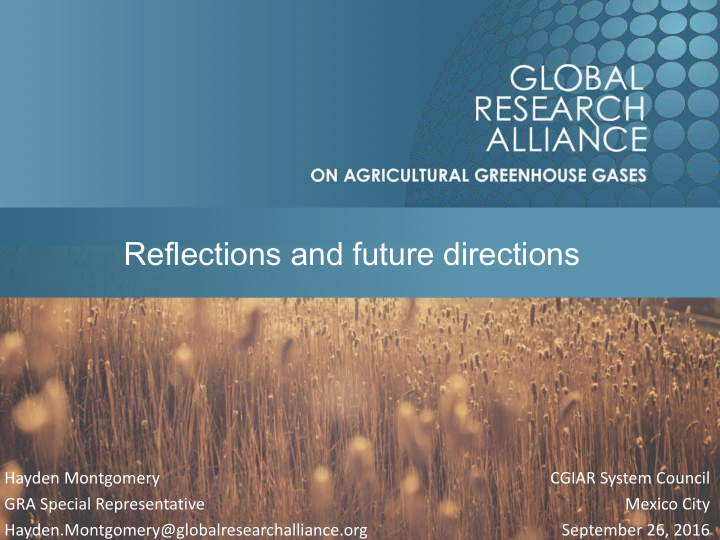



Reflections and future directions Hayden Montgomery CGIAR System Council GRA Special Representative Mexico City Hayden.Montgomery@globalresearchalliance.org September 26, 2016
WHAT IS THE GRA? • Inter-Governmental Organisation • Launched in December 2009 • Operationalised in June 2011 at Ministerial Summit • Governed by a Council of Members • Guided by a Charter • Activities undertaken by four Research Groups • Supported by a Secretariat and Special Representative
OBJECTIVES OF GRA Underlining the need for food security , and to promote synergies between adaptation and mitigation efforts, the Members set forth the following Charter for the Global Research Alliance on Agricultural Greenhouse Gases (“the Alliance”). The Alliance for voluntary action provides a framework to increase cooperation and investment in research activities to reduce the emissions intensity of help agricultural production systems and increase their potential for soil carbon sequestration , and improve their efficiency , productivity , resilience and adaptive capacity , thereby contributing in a sustainable way to overall mitigation efforts, while still helping meet food security objectives.
MEMBERSHIP 46 Member Countries Ecuador • Argentina Korea Philippines • • • Egypt • Australia Lithuania Poland • • • Finland • Belgium Malaysia Spain • • • France • Bolivia Mexico Sri Lanka • • • Germany • Brazil Nicaragua Sweden • • • Ghana • Canada Netherlands Switzerland • • • Honduras • Chile New Zealand Thailand • • • Indonesia • China Norway Tunisia • • • Italy • Colombia Panama United Kingdom • • • Ireland • Costa Rica Paraguay United States • • • Japan • Denmark Peru Uruguay • • • Dominican Vietnam • • Republic
PARTNERS OF THE GRA
REFLECTING ON LAST 5 YEARS • Operationalising the Charter • Expanding membership • Development of Partnerships • Establishment (and restructuring) of Research Groups and Networks • Development of work programmes • Addressing capability within the membership – fellowships and regional training activities • Generation of knowledge fundamental to underpin future innovations • Best practice guidelines
REVIEW OF PERFORMANCE Identified weaknesses of GRA: q Lacking visibility – not helped by proliferation of initiatives q Inadequate resources for participation of countries and for supporting research group activities q Struggle to maintain momentum – rotational chairing q Inactive Partnerships The response: q Established research collaboration working group to explore mechanisms for resourcing research and other activities q Commenced development of the first Strategic Plan and Flagship Projects q Enhanced GRA Secretariat, including establishment of new Special Representative position to help address weaknesses and give more visibility, intervene to help research groups, connect partners to work of groups, identify resources, act as interface between council and research groups, amongst other tasks.
THE NEXT 5 YEARS? More dynamic relationship between GRA Research Groups and Council • More active and mutually beneficial relationships with GRA Partners • Identification and articulation of top priorities for GRA (Flagships) • Strategic Plan • q Four pillars: research collaboration; information transfer; effective partnerships; mobilising resources. q Identifies objectives and actions to meet objectives Flagship projects • q Developed by Research Groups with Partners and adopted by GRA Council q Flagship proposals are in three broad areas: addressing adoption barriers with known technologies or practises, generating new knowledge, making it count, big data…
GRA FLAGSHIP IDEAS – A PREVIEW Demonstration of mitigation through water management in Healthy and resilient livestock Enteric fermentation mitigation rice production systems; low systems – animal and plant hub – validation of practices that methane, high yield, low cost, selection for resilience, impact of improve productivity and low risk. disease incidence on GHGs livelihoods and mitigate emissions. Making practices count – moving to advanced Soil carbon sequestration – GHG inventories to measurement guidelines, eliminate trade-off Collection, determining technical and between mitigation management and economic mitigation potential, and food security. user-friendly validation of practices, provision of data. improvement of decision making tools, Inter-comparison and improvement of models Effect of rice Nitrogen use efficiency - cultivars on management of feeds, pasture, methane animals, waste, fertilizers, emissions maximizing biological nitrogen fixation
GRA and the CGIAR Joint mapping of respective activities so that relevant activities of CGIAR are • fully integrated into GRA Strategic Plan and linked to GRA Flagships CGIAR Centers as hubs for joint GRA-CGIAR activity: • q Regional or sector/system specific research q Utilisation of laboratories q Regional workshops Opportunities for working together on education and training: • q Scientist exchanges q Scholarships/fellowships q Training workshops Joint organisation of scientific conferences •
FOR MORE INFORMATION • www.globalresearchalliance.org • secretariat@globalresearchalliance.org • Twitter: @GRA_GHG
Recommend
More recommend